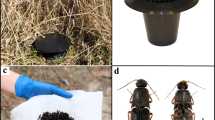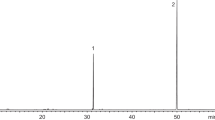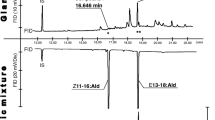Abstract
Wireworms, the larvae of click beetles (Coleoptera: Elateridae), are soil-dwelling insect pests inflicting major economic damage on many types of agricultural crops worldwide. The objective of this work was to identify the female-produced sex pheromones of the Pacific Coast wireworm, Limonius canus LeConte, and the sugarbeet wireworm, L. californicus (Mannerheim) (Coleoptera: Elateridae). Headspace volatiles from separate groups of female L. canus and L. californicus were collected on Porapak Q and analyzed by gas chromatography with electroantennographic detection (GC-EAD) and GC-mass spectrometry. GC-EAD recordings revealed strong responses from male L. canus and male L. californicus antennae to the same compound, which appeared below GC detection threshold. The structure of this candidate pheromone component was deduced from the results of micro-analytical treatments of extracts, retention index calculations on four GC columns, and by syntheses of more than 25 model compounds which were assessed for their GC retention characteristics and electrophysiological activity. The EAD-active compound was identified as (E)-4-ethyloct-4-enoic acid, which we name limoniic acid. In field experiments in British Columbia and Alberta, Canada, traps baited with synthetic limoniic acid captured large numbers of male Limonius click beetles, whereas unbaited control traps captured few. Compared to traps baited with the analogue, (E)-5-ethyloct-4-enoic acid, traps baited with limoniic acid captured 9-times more male L. californicus, and 6.5-times more male western field wireworms, L. infuscatus Motschulsky, but 2.3-times fewer male L. canus. Limoniic acid can now be developed for detection, monitoring and possibly control of L. californicus, L. infuscatus and L. canus populations.









Similar content being viewed by others
Data Availability
Data are reported in the manuscript and in the electronic Supplementary Information.
References
Andrews KR, Gerritsen A, Rashed A, Crowder DW, Rondon SI, van Herk WG, Vernon R, Wanner KW, Wilson CM, New DD, Fagnan MW (2020) Wireworm (Coleoptera: Elateridae) genomic analysis reveals putative cryptic species, population structure, and adaptation to pest control. Commun Biol 3:1–13
Baker TC (1985) Insect mating and courtship behavior. In: Kerkut GA, Gilbert LI (eds) Comprehensive insect physiology. Biochemistry and Pharmacology. Pergamon Press, New York, pp 621–672
Butler LI, McDonough LM, Onsager JA, Landis BJ (1975) Sex pheromones of the Pacific coast wireworm, Limonius canus. Environ Entomol 4:229–230
Butlin RK (1987) Speciation by reinforcement. Trends Ecol Evol 2:8–13
Cardé RT, Baker TC (1984) Sexual communication in insects. In: Bell W, Cardé RT (eds) Chemical ecology of insects. Sinauer, Sunderland, Massachusetts, pp 355–386
Dunkelblum E, Tan SH, Silk PJ (1985) Double-bond location in monounsaturated fatty acids by dimethyldisulfide derivatization and mass spectrometry: application to analysis of fatty acids in pheromone glands of four Lepidoptera. J Chem Ecol 11:265–277
Etzler FE, Wanner KW, Morales-Rodriguez A, Ivie MA (2014) DNA barcoding to improve the species-level management of wireworms (Coleoptera: Elateridae). J Econ Entomol 107:1476–1485
Furlan L, Conterio B, Chiarini F, Benvegnu I, Tóth M (2020) The use of click beetle pheromone traps to optimize the risk assessment of wireworm (Coleoptera: Elateridae) maize damage. Sci Rep 10:8780. https://doi.org/10.1038/s41598-020-64347-z
Gries G, Schaefer PW, Gries R, Liška J, Gotoh T (2001) Reproductive character displacement in Lymantria monacha from northern Japan. J Chem Ecol 27:1163–1176
Gries R, Khaskin G, Gries G, Bennett RG, King GGS, Morewood P, Slessor KN, Morewood WD (2002) (Z,Z)-4,7-Tridecadien-(S)-2-yl acetate: sex pheromone of Douglas-fir cone gall midge, Contarinia oregonensis. J Chem Ecol 28:469–478
Jacobson M, Lilly CE, Harding C (1968) Sex attractant of sugar beet wireworm: identification and biological activity. Sci (Washington) 159:208–210
Lehman RS (1932) Experiments to determine the attractiveness of various aromatic compounds to adults of the wireworms Limonius (Pheletes) canus Lec. And Limonius (Pheletes) californicus Mann. J Econ Entomol 25:949–958
Leung JPS (2018) The response of Agriotes obscurus click beetles to pheromone and its impact on the acquisition of a fungal pathogen. MPM thesis. Simon Fraser University, Burnaby, BC, Canada
Lilly CE (1959) Response of males of Limonius californicus (Mann) to a sex attractant separable by paper chromatography. Can Entomol 91:145–146
Linn CE, Roelofs WL (1995) Pheromone communication in moths and its role in the speciation process. In: Lambert DM, Spencer HG (eds) Speciation and the recognition concept. John Hopkins University Press, Baltimore, Maryland, pp 263–300
Milosavljević I, Esser AD, Crowder DW (2016) Effects of environmental and agronomic factors on soil-dwelling pest communities in cereal crops. Agric Ecosyst Environ 225:192–198
Morales-Rodriguez A, O'Neill RP, Wanner KW (2014) A survey of wireworm (Coleoptera: Elateridae) species infesting cereal crops in Montana. Pan-Pac Entomol 90:116–125
Onsager JA, McDonough LM, George DA (1968) A sex pheromone in the Pacific coast wireworm. J Econ Entomol 61:691–693
Reddy GVP, Tangtrakulwanich K, Wu S, Miller JH, Ophus VL, Prewett J, Jaronski ST (2014) Evaluation of the effectiveness of entomopathogens for the management of wireworms (Coleoptera: Elateridae) on spring wheat. J Invertebr Pathol 120:43–49
Serrano JM, Zou Y, Millar JG (2020) Identification of a hyperactive pheromone analog in field tests of pheromone mimics for two click beetle species in the genus Cardiophorus (Coleoptera: Elateridae). Chemoecology 30:297–304. https://doi.org/10.1007/s00049-020-00319-z
Staddon BW, Everton IJ (1980) Haemolymph of milkweed bug Oncopeltus fasciatus (Heteroptera: Lygaeidae): inorganic constituents and amino acids. Comp Biochem Physiol 65A:371–374
Tóth M (2013) Pheromones and attractants of click beetles: an overview. J Pest Sci 86:3–17
Traugott M, Benefer C, Blackshaw RP, van Herk WG, Vernon RS (2015) Biology, ecology, and control of elaterid beetles in agricultural land. Annu Rev Entomol 60:313–334
Van Den Dool H, Kratz PD (1963) A generalization of the retention index system including linear temperature programmed gas–liquid partition chromatography. J Chromatogr 2:463–471
van Herk WG, Vernon RS (2014) Click beetles and wireworms (Coleoptera: Elateridae) of Alberta, Saskatchewan, and Manitoba. In: Giberson DJ, Carcamo HA (eds) Arthropods of Canadian grasslands, vol. 4. Biological Survey of Canada, Ottawa, pp 87–117
van Herk WG, Labun TJ, Vernon RS (2018a) Efficacy of diamide, neonicotinoid, pyrethroid, and phenyl pyrazole insecticide seed treatments for controlling the sugar beet wireworm, Limonius californicus (Coleoptera: Elateridae), in spring wheat. J Entomol Soc Brit Columbia 115:86–100
van Herk WG, Vernon RS, Borden JH (2018b) A pheromone-baited pitfall trap for monitoring Agriotes spp. click beetles (Coleoptera: Elateridae) and other soil surface insects. J Entomol Soc BC 115:101–103
Vernon RS, van Herk WG (2013) Wireworms as pests of potato. In: Giordanengo P, Vincent C, Alyokhin A (eds) Insect pests of potato: global perspectives on biology and management. Academic Press, Elsevier, Amsterdam, pp 103–164
Vernon WG, Blackshaw RP, van Herk WG, Clodius M (2014) Mass trapping wild Agriotes obscurus and A. lineatus males with pheromone traps in a permanent grassland population reservoir. Agric For Entomol 16:227–239
Acknowledgements
We thank Jocelyn Millar for a most valuable suggestion regarding the interpredation of DMDS treatment results, Associate Editor David Hall for his meticulous review of the manuscript, Sharon Oliver for word processing and comments, Russ Alcock and Blaine Dunlop for permitting access to their farms, David Shack, Emmanuel Hung, and Sebastian Damin for assistance with processing beetles, Stephen Takács for help with graphical illustrations, and two anonymous reviewers for complimentary comments. The research was supported by an AAFC Canadian Agricultural Partnership Cluster Project (Developing IPM tools for wireworm management in Canada) administered by the Canadian Horticulture Council and supported by the Potato Growers of Alberta, the B.C. Potato Industry Development Committee, the B.C. Lower Mainland Horticultural Improvement Association, and by a Natural Sciences and Engineering Research Council of Canada (NSERC) – Industrial Research Chair to GG, with BASF Canada Inc. and Scotts Canada Ltd. as the industrial sponsors.
Funding
The research was supported by an AAFC Canadian Agricultural Partnership Cluster Project (Developing IPM tools for wireworm management in Canada) administered by the Canadian Horticulture Council and supported by the Potato Growers of Alberta, the B.C. Potato Industry Development Committee, the B.C. Lower Mainland Horticultural Improvement Association, and by a Natural Sciences and Engineering Research Council of Canada (NSERC) – Industrial Research Chair to GG, with BASF Canada Inc. and Scotts Canada Ltd. as the industrial sponsors.
Author information
Authors and Affiliations
Contributions
WvH & GG conceived the study; WvH and HC captured beetles for pheromone analyses; RG captured headspace odorants, and analyzed odorant extract as well as model compounds by GC-EAD and GC-MS; SA synthesized chemicals; WvH, HC, SM and EL ran field experiments; EL and WvH identified and determined the sex of beetles captured in traps; WvH analyzed capture data statistically; RG and GG wrote the first draft, and all authors reviewed and approved of the final draft.
Corresponding author
Ethics declarations
Conflict of Interest / Competing Interests
The authors declare no conflicts of interest.
Ethics Approval
Not applicable
Consent to Participate
Not applicable
Consent for Publication
All authors approved of the submission of the manuscript.
Code Availability
Not applicable
Additional information
Regine Gries and Gerhard Gries are dedicating this article to Prof. Dr. Dr. h.c. mult. Wittko Francke, in memoriam.
Supplementary Information
ESM 1
(PDF 3750 kb)
Rights and permissions
About this article
Cite this article
Gries, R., Alamsetti, S.K., van Herk, W.G. et al. Limoniic Acid - Major Component of the Sex Pheromones of the Click Beetles Limonius canus and L. californicus. J Chem Ecol 47, 123–133 (2021). https://doi.org/10.1007/s10886-020-01241-y
Received:
Revised:
Accepted:
Published:
Issue Date:
DOI: https://doi.org/10.1007/s10886-020-01241-y




